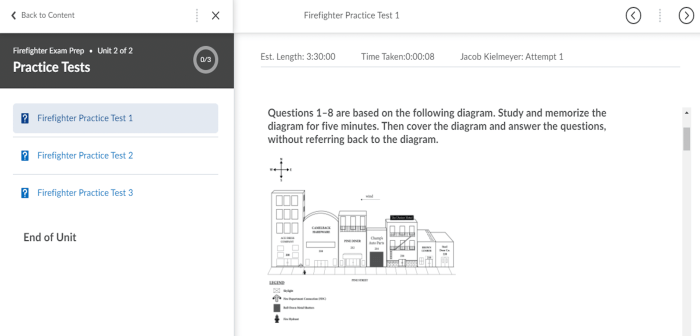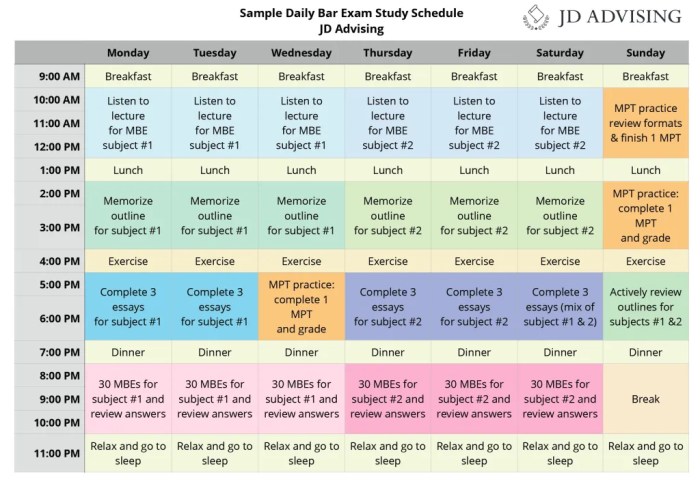Firefighter 1 & 2 exam prep – Embark on an exhilarating journey towards becoming a firefighter with our comprehensive guide to the Firefighter 1 & 2 exam. This essential preparation resource will empower you with the knowledge and strategies to excel in every aspect of the exam, from the written test to the physical ability assessment and oral interview.
Dive into a wealth of insights, expert tips, and sample questions that will equip you with the confidence and skills to conquer the exam and secure your dream career as a firefighter.
Firefighter Exam Overview
Firefighter 1 and 2 exams are standardized assessments designed to evaluate candidates’ knowledge, skills, and abilities required for entry-level firefighter positions. These exams play a crucial role in the hiring process, ensuring that only the most qualified individuals are selected for this demanding and critical role.
The structure of firefighter exams varies depending on the specific jurisdiction and testing agency. However, most exams typically consist of multiple sections covering a range of topics relevant to firefighting, including:
- Firefighting Principles and Practices
- Building Construction and Inspection
- Hazardous Materials
- Emergency Medical Services (EMS)
- Physical Ability
The types of questions included in firefighter exams vary widely. Common question formats include multiple choice, true/false, short answer, and essay. Multiple choice questions typically present candidates with several options, from which they must select the best answer. True/false questions require candidates to indicate whether a statement is true or false.
Short answer questions ask candidates to provide brief written responses to specific questions. Essay questions allow candidates to demonstrate their knowledge and understanding of a particular topic in more depth.
The scoring system for firefighter exams is typically based on the number of correct answers. Each question is assigned a specific point value, and candidates’ scores are calculated by totaling the points earned on all questions. Passing requirements vary depending on the jurisdiction and testing agency.
Firefighter 1 & 2 exam prep can be challenging, but with the right resources, you can increase your chances of success. For example, if you’re struggling with understanding the historical context of the exam, you might want to check out this war of 1812 dbq answer key . Once you’ve got a good grasp of the history, you can come back to your firefighter 1 & 2 exam prep feeling more confident.
Some exams require candidates to achieve a minimum score in each section, while others only require a passing score on the overall exam.
Exam Preparation Strategies

Preparing for the Firefighter 1 & 2 exam requires a comprehensive approach. Effective study techniques, understanding the job requirements, and utilizing various resources are crucial for success.
Comprehending the specific demands of the firefighter profession is essential. Review job descriptions and consult with current or retired firefighters to gain insights into the daily responsibilities and challenges.
Effective Study Techniques
- Spaced Repetition:Review material at increasing intervals to enhance retention.
- Active Recall:Test yourself regularly by trying to recall information without referring to notes.
- Chunking:Break down large amounts of information into smaller, manageable chunks.
- Pomodoro Technique:Alternate focused study sessions with short breaks to maintain concentration.
Recommended Resources
- Books:Firefighting Principles and Practice, Fire Service Hydraulics and Water Supply
- Online Courses:Fire Science Online, National Fire Academy
- Practice Tests:Firefighter Exam Prep, Firefighter Study Guide
Written Exam Content

The written exam for Firefighter 1 & 2 certification covers various subject areas essential for firefighting operations. These include:
- Firefighting Principles and Procedures
- Building Construction and Fire Behavior
- Hazardous Materials
- Emergency Medical Services
- Fire Prevention and Public Education
Firefighting Principles and Procedures
This section tests your understanding of fundamental firefighting concepts, including:
- Fire chemistry and extinguishing agents
- Firefighting tactics and strategies
- Fire hose handling and nozzle operations
- Ventilation and forcible entry techniques
Building Construction and Fire Behavior
Questions in this section assess your knowledge of building construction materials, structural components, and how these factors influence fire behavior. You will be tested on:
- Types of building construction
- Fire resistance ratings of materials
- Fire spread patterns in different building types
- Structural collapse hazards
Hazardous Materials
This section covers the identification, classification, and handling of hazardous materials, including:
- Flammable and combustible liquids
- Toxic and corrosive substances
- Radioactive materials
- Emergency response procedures for hazardous materials incidents
Emergency Medical Services
Questions in this section test your knowledge of basic first aid, CPR, and emergency medical procedures, such as:
- Patient assessment and stabilization
- Oxygen administration
- Immobilization and splinting techniques
- Medical emergencies commonly encountered in firefighting
Fire Prevention and Public Education
This section assesses your understanding of fire prevention and public education programs, including:
- Fire safety codes and regulations
- Fire inspection and code enforcement
- Public education campaigns and materials
- Community involvement in fire prevention
Physical Ability Test: Firefighter 1 & 2 Exam Prep

Firefighting demands exceptional physical abilities. To assess these capabilities, prospective firefighters undergo a physical ability test (PAT) that evaluates their strength, endurance, agility, and coordination.
The PAT typically comprises several components, including:
Stair Climb
- Simulates the strenuous task of climbing stairs while wearing full gear.
- Candidates must ascend and descend a specified number of flights within a set time limit.
Hose Drag
- Tests the ability to pull a charged hose line.
- Candidates must drag a hose over a designated distance in a specified time.
Ladder Raise and Extension
- Evaluates the strength and coordination required to raise and extend a ladder.
- Candidates must raise a ladder to a certain height and extend it to a specific length within a set time.
Forcible Entry
- Simulates the task of breaking down a door or window.
- Candidates must use a tool to force open a door or window within a set time.
Equipment Carry
- Tests the ability to carry heavy equipment.
- Candidates must carry a specified weight over a designated distance within a set time.
To prepare for the PAT, it is essential to engage in regular physical training that focuses on improving strength, endurance, and agility. Practice the specific components of the test to enhance your performance and confidence on the exam day.
Oral Interview

The oral interview is a crucial component of the firefighter exam, providing an opportunity for the department to assess your communication skills, professionalism, and suitability for the role.
The format typically involves a panel of interviewers who ask a series of questions to evaluate your knowledge, experience, and fit within the fire department.
Types of Questions, Firefighter 1 & 2 exam prep
- Behavioral Questions:These questions focus on your past experiences and how you have handled specific situations, such as working in a team, responding to emergencies, or overcoming challenges.
- Technical Questions:These questions assess your knowledge of firefighting techniques, equipment, and safety protocols.
- Motivational Questions:These questions aim to understand your reasons for pursuing a career in firefighting and your commitment to the role.
Preparation Tips
To prepare effectively for the oral interview:
- Research the fire department and its specific requirements.
- Practice answering common interview questions using the STAR method (Situation, Task, Action, Result).
- Prepare questions to ask the interviewers, demonstrating your interest and engagement.
- Dress professionally and arrive on time for the interview.
- Be confident, articulate, and enthusiastic during the interview.
Sample Questions and Practice Tests

Taking practice tests is crucial for preparing for firefighter exams. These tests help you gauge your knowledge, identify areas for improvement, and improve your test-taking skills.
Sample Questions
Here are some sample questions from different exam sections:
| Section | Sample Question |
|---|---|
| Written Exam | Which of the following is a Class A fire? |
| Physical Ability Test | What is the minimum distance required for the 100-yard dash? |
| Oral Interview | Describe your experience in working as a team member. |
Practice Tests
Reputable sources for practice tests include:
- Firefighter Exam Prep Academy: https://firefighterexamprepacademy.com/
- Fire Prep Unlimited: https://fireprepunlimited.com/
- Firehouse Exam Prep: https://firehouseexamprep.com/
Benefits of Practice Tests
Taking practice tests offers numerous benefits:
- Identify knowledge gaps and areas for improvement
- Simulate the actual exam environment and reduce test anxiety
- Improve time management skills
- Build confidence and increase the likelihood of success
Effective Use of Practice Tests
To use practice tests effectively:
- Take tests under timed conditions to simulate the actual exam
- Review incorrect answers and focus on understanding the concepts
- Identify patterns and areas where you consistently struggle
- Revise the material and practice until you achieve consistent improvement
FAQ Explained
What is the purpose of the Firefighter 1 & 2 exam?
The Firefighter 1 & 2 exam is a standardized test designed to assess the knowledge, skills, and abilities required for entry-level firefighters.
What types of questions are included in the written exam?
The written exam typically covers topics such as firefighting principles, building construction, hazardous materials, and emergency medical services.
How can I improve my physical fitness for the physical ability test?
Engage in regular cardiovascular exercise, strength training, and practice the specific skills required for the test, such as hose pulls and ladder raises.